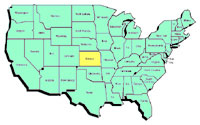
Worksheets and No Prep Teaching Resources
Kansas Becomes a State
 Worksheets and No Prep Teaching Resources |
Kansas Becomes a State |
| edHelper's suggested reading level: | grades 4 to 6 | |
| Flesch-Kincaid grade level: | 10 |
| Print Kansas Becomes a State (font options, pick words for additional puzzles, and more) |
|
| Quickly print reading comprehension |
|
| Print a proofreading activity |
| Leave your feedback on Kansas Becomes a State (use this link if you found an error in the story) |
|
Kansas Becomes a State
By Susan Karnes |

|
 1 On January 29, 1861, Kansas became the 34th state to be admitted into the Union. However, the history of Kansas dates back more than 300 years prior to its statehood. Kansas history is a story of turmoil and bloodshed as its people fought for what they believed; of triumph as they lived their dreams; and of prosperity as the state of Kansas today.
1 On January 29, 1861, Kansas became the 34th state to be admitted into the Union. However, the history of Kansas dates back more than 300 years prior to its statehood. Kansas history is a story of turmoil and bloodshed as its people fought for what they believed; of triumph as they lived their dreams; and of prosperity as the state of Kansas today.